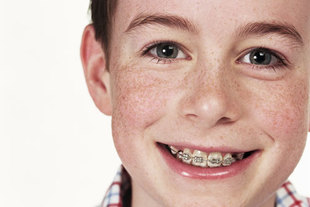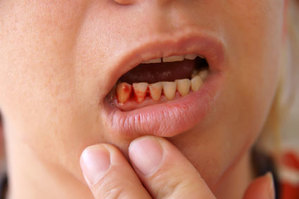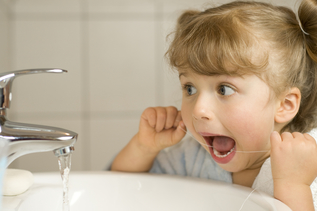 Most parents are very good in providing their children dental care at home. We write notes on dental appointments, limit intake of sugary foods like candies and make reminder charts to remind them to brush and floss. But most children spend most of their waking hours away from home, from their mom and dad. Below are some simple means in which to encourage proper dental hygiene of children while at school. Employ changes in their snack Most schools nowadays have snack counters and vending machines that are available to school children during snack time, lunch and after school. Because of this, your kids have access to candies, soda, ice cream, chips and other unhealthy foods every single day. Do some changes on their snack selection by providing healthier options such as orange slices, apple, bottled water and string cheese. This will help your child’s general health, particularly dental health. Create a healthy lunch It’s good for your child to send him off with a lunch full of healthy foods that can help strengthen the teeth. Cheese and yogurt are rich in calcium, which is great for strong bones and teeth. Fruits and vegetables that are rich in antioxidants and vitamins are good for promoting healthy mouth. Crunchy food such as celery, apples and carrots can help remove plaque. Protest sugary beverages You can petition to get sugary beverages such as soda be removed from school vending machines. Aside from coating your child’s teeth with sugar to feed on bacteria, these sugary drinks can also cause staining of the teeth. Milk and bottled water are good options for bright, healthy smile. Encourage brushing Tooth brushing and flossing should not only be done at home. To encourage brushing, you can talk to your child’s teacher on allotting time for the entire class to brush their teeth after taking their lunch. You can also ask your local dentists to donate brushes, floss, mouthwash and toothpaste and talk in front of the class to raise awareness on the significance of proper dental care. See the Emergency Contact Information Don’t forget to check the school’s contact information regarding the record of their school dentist. Make sure they are up-to-date just in case a dental emergency happens during the day. Children’s dental care is very important regardless on their whereabouts. Teach them the benefits of taking care of their teeth and mouth while they’re away from home to ensure that all your efforts are not being wasted when the kids are at school or away from you.  Caring your child’s braces and teeth can be challenging, so having an understanding on dental hygiene and possible dental problems that may surface becomes more important than ever before. Taking care of braces is necessary in preventing problems while they’re on and later on having a beautiful smile when they are removed. Importance of Proper Oral Hygiene for Kids with Braces Proper dental hygiene is key in preventing common problems such as demineralization, gingivitis and plaque build-up, however, it is more important during the time when a child wears orthodontic appliance such as braces. Oral hygiene is more complicated with braces on, and kids are more susceptible to dental problems. The dental problems mentioned above can be miserable to deal on their own, but if ignored and left untreated, they have the potential to cause secondary dental health problems. Sometimes, the dentist may have to remove the braces and buy some time for the gums and mouth issues to recover before reattaching the braces. How to Correctly Brush and Floss Teeth with Braces Children with braces should take extra care when cleaning their teeth. Brushing 4 times a day is a great way to remove plaque and food particles from building up in their metal braces. The toothbrush should also be replaced more often, especially if the braces begin to wear down or fray. 1. Hold the toothbrush parallel to the floor. 2. Move the brush in circular motions, moving from tooth to tooth, going to the curve of the gums and teeth. 3. Brush every tooth for a few seconds, the back of the mouth, insides of the teeth and behind and sides of the molars, the tongue and the roof of the tongue. Brush in an upward-downward motion. 4. To clean the brackets, angle the brush when brushing them. Flossing can be a hassle, but this is very important to be done every night after tooth brushing. For children with braces, you have to use ‘threader floss’ to be able to floss around wires. This floss has stiff ends that allows flossing between brackets. Choosing the Right Toothbrush, Toothpaste and Mouthwash When brushing teeth with braces, use a toothbrush with soft bristles. Brushing using a manual toothbrush will increase the risk of leaving plaque and food particles behind. It is highly encouraged to use power toothbrush. No specific toothpaste is necessarily needed for brushing teeth with braces, but the use of fluoride-enriched toothpaste is encouraged. Choosing a type of toothpaste that features comprehensive protection helps keep optimal oral health. Children is recommended to use mouthwash two times a day for a minute every time to rinse the brackets. The use of mouthwash will help clean the little gaps between the teeth where food residue could still be trapped after flossing and brushing.  Are bleeding gums in kids something to worry about? Bleeding gums during flossing or brushing may be the initial sign of gingivitis, a form of gum disease. While gum disease is common among adults, kids can have a similar dental problem too.  Possible Causes of Bleeding Gums in Kids Gum disease isn’t the only possible cause of gum bleeding among children. The American Dental Association reported that a new flossing routine as the possible culprit of the bleeding. Is your child flossing every day? When he skipped for several days, then some bleeding may occur when he begins to floss again. Guide your child when flossing until he is old enough to clean his teeth independently (around ten years of age). Do a daily reminder to reinforce proper flossing habits. Brushing your teeth two times a day with daily flossing is the key to the prevention of gum disease. Vigorous brushing can irritate the gums, causing some bleeding. Gently brush your teeth with soft-bristled toothbrush. Encourage them to spend two minutes brushing, including the tongue for a clean, healthy mouth. Children can also have gum bleeding by not brushing regularly. When teeth are not brushed, gums can become inflamed and swollen due to the plaque staying on the gumline too long. The plaque is a film of bacteria that coats the teeth after eating. Sometime, gum bleeding can be caused by a deficiency of a certain Vitamin. Vitamin C is beneficial for keeping gums healthy. Give your child daily vitamins or introduce fruits and vegetables with Vitamin C into his diet. What to Do with Gum Bleeding Bleeding due to a change in flossing routine or a vigorous brushing technique must clear up after a week once flossing is done regularly or your child uses a soft-bristled brush. Gum bleeding, if accompanied with signs of bad breath, redness, tenderness or a receding gumline, may be a sign of gingivitis, or could be a more advanced stage of gum disease. The American Academy of Periodontology reported that gingivitis is a common problem among kids too. The ones especially at risk are the older children as changes in the hormone balance during puberty can increase the flow of the blood to the gum, causing gum tissue to be more susceptible to tenderness and swelling. Flossing, brushing and regular dental checkups are key to the prevention and treatment of gum bleeding and gingivitis. Gum bleeding in children can be a sign of gingivitis. The sooner you child is seen by his dentist, the better. If left ignored, gingivitis can lead to more serious stages of gum disease, which may be hard to reverse. If you notice that your child’s gums bleed easily or exhibit other signs, talk to your child’s dentist. |
AuthorMint Kids Dentistry Archives
July 2021
Categories |
Location |
|
Sitemap
|
Forms
|

 RSS Feed
RSS Feed